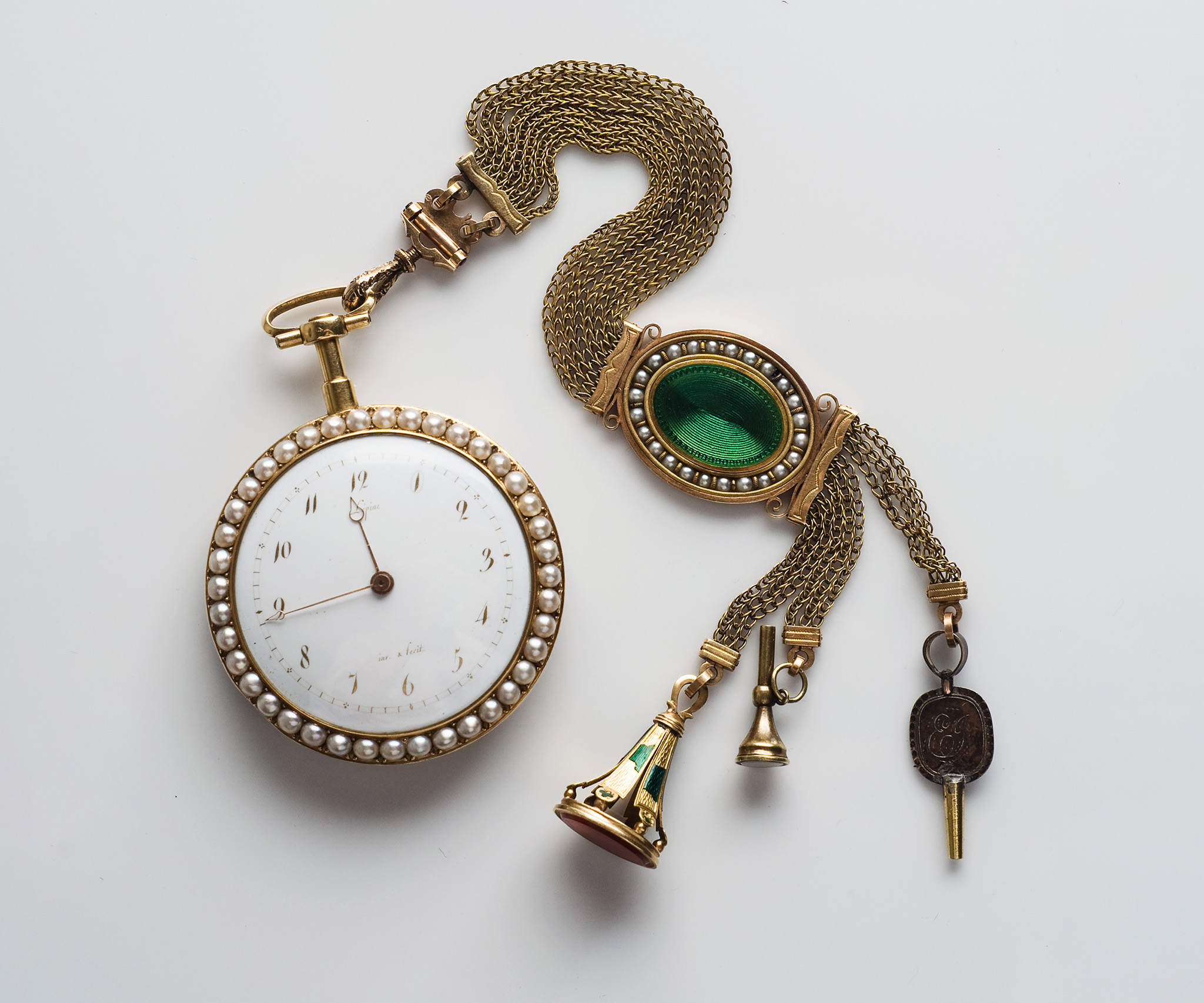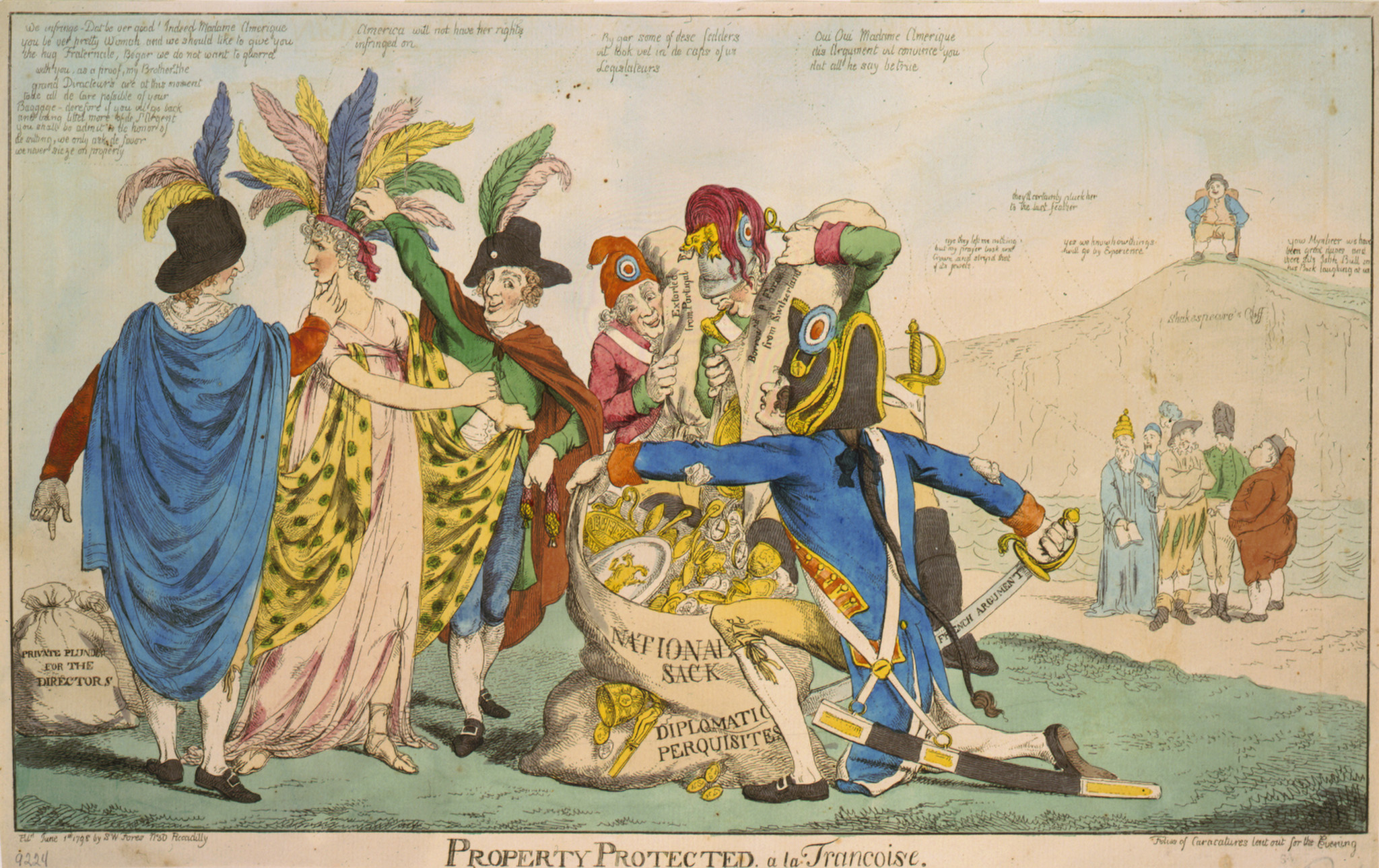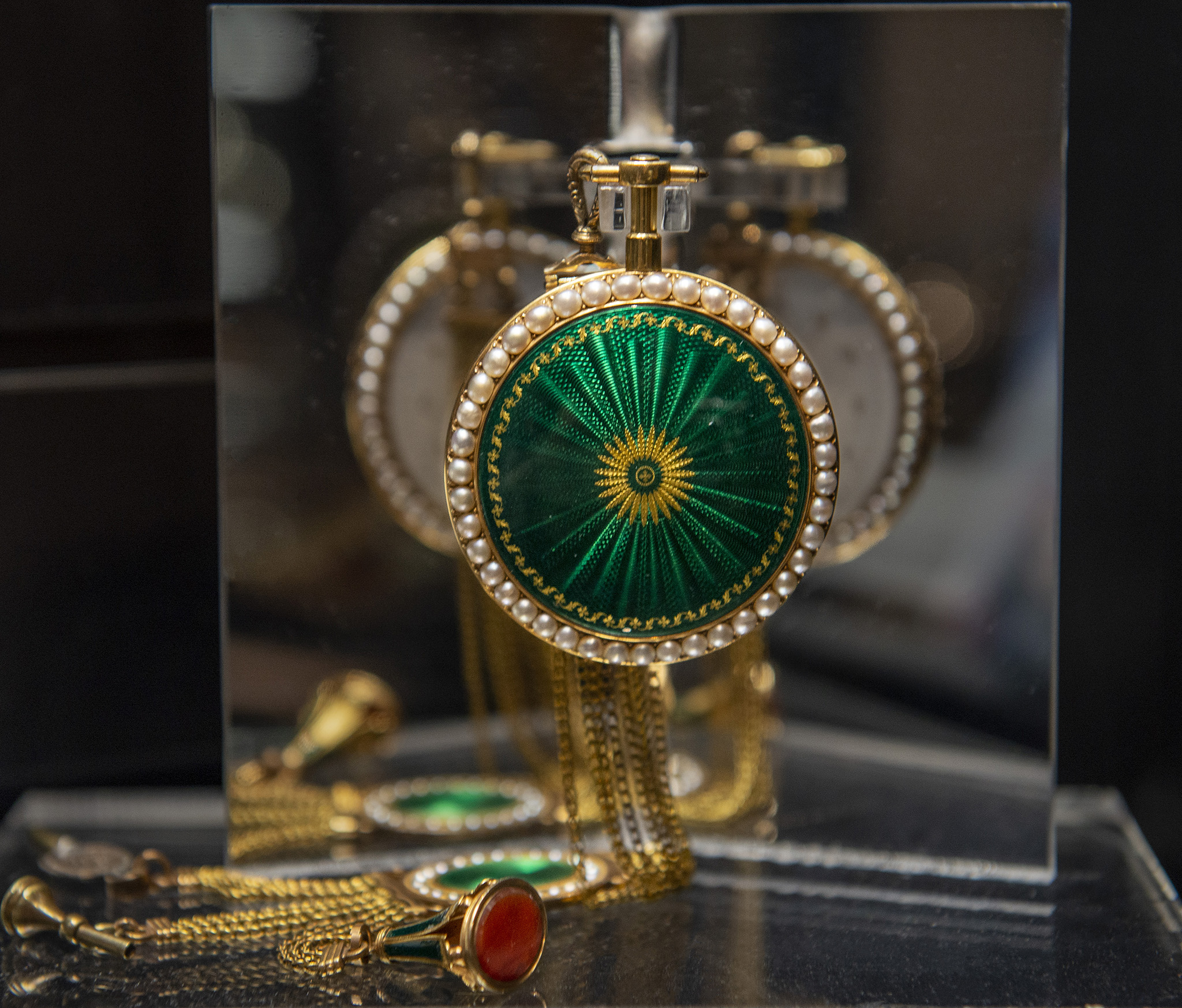L is for Lépine: How The XYZ Affair Interfered with the Gift of a Watch
Gold pocket watch, 1797, with pearl and green enamel embellishments attached to a gold chain fob with seals and a watch key. Created by Lépine in Paris, France, and gifted to Eliza Izard (1784-1862) of Charleston. From the collections of The Charleston Museum, HQ 184.
When Mary Stead Pinckney (1752-1812) first considered purchasing a watch as a gift for her teenage niece Eliza Izard (1784-1862), she likely had no idea that a diplomatic foreign relations scandal would complicate the process.
Mary Stead Pinckney, the second wife of Charles Cotesworth Pinckney (1746-1825), traveled often with her husband as his political career took him overseas, spending much of the 1790s in Europe. In 1796 they were headed to Paris, France, for Pinckney to take up his post as Minister Plenipotentiary, ambassador for the United States. Paris was then the capital of fashion for Europe, an internationally renowned center for arts and design, and home to one of the most preeminent watchmaking firms of the day, Lépine.
Jean Antoine Lépine (1720-1814) was born in a French town close to Geneva, Switzerland, and in his teen years was apprenticed to Decrose of Grand Sacconex. At age 24 he moved to Paris, France, where he worked with André-Charles Caron (1698–1775), then clockmaker to King Louis XV (1710-1774). In 1756 Lépine married Caron’s daughter, Madeleine-Françoise (1734-Unknown), and was made a journeyman partner in the firm. He would attain mastery, then take over the firm of Caron et Lépine in 1761. Caron retired early in order to advance the political career and court aspirations of his son, Pierre-Auguste Caron de Beaumarchais (1732-1799). By 1766 Lépine would be appointed Horologer du Roi, a title he would use up until the French Revolution made it politically inadvisable. In 1783, Lépine would hand over the formal work of the business to his own son-in-law, Claude Pierre Raguet (1753-1810), who maintained the family name. The firm would continue to be known as Lépine until 1916.
Another angle of light in this photograph shows off the slim profile of the watch, as well as details on the fob and seals.
In the mid-1760s, Lépine created his eponymous calibre, a new advancement in watch design. While early 18th century pocket watches were fairly rounded, the new Lepine calibre allowed for a much slimmer construction, creating the base mechanics used for today’s wristwatches. With this accomplishment among other technological advances, Lépine became the preeminent watchmaker in Paris, not just for technique, but for the aesthetics of his design. His watches were sought after by many high profile figures, including George Washington (1732-1799). Washington wrote to Gouveneur Morris in Paris in 1788 requesting “I wish to have a gold watch procured for my own use…about the size and kind of that which was procured by Mr. Jefferson for Mr. Madison (which was large and flat)”(Fales, 129).
Mary Stead Pinckney was very concerned with the design of the watch she ordered for Eliza Izard, but she would have to entrust another with overseeing the order process. In 1797, she and her husband ended up staying in Amsterdam, not Paris, because the French Directoire government was less than receptive to Pinckney’s diplomatic efforts.
British political cartoon “Property protected–à la Françoise” from 1798 satirizing the XYZ Affair. The image depicts the French Directory robbing a feminized America while European representatives look on from a distance. From the Collections of The Library of Congress.
Charles Cotesworth Pinckney and his compatriots, Elbridge Gerry and John Marshall, were tasked specifically by President Adams to settle the matter of seizures of American merchant ships by the French. However, the Foreign Minister, the Marquis de Talleyrand, would not meet with them and instead sent intermediaries later designated as figures W, X, Y, and Z. Pierre Beaumarchais, brother-in-law of watchmaker Jean Antoine Lépine, would also get involved in these negotiations. Beaumarchais had previously been working to funnel French aid to the United States during the American Revolution.
Talleyrand requested the following before he would even meet with the American coalition: France would need a low-interest loan, the American merchant claims against the French would be paid off, and a substantial bribe would be paid to Talleyrand himself. These requests rather shocked the American government, and kicked off a diplomatic quasi-war of skirmishes and naval engagements, leading to rising tensions between America and France. It took several years before the matter was finally resolved in the Convention of 1800.
With the Pinckneys in Amsterdam amid the rising scandal of what was dubbed The XYZ Affair, Mary Stead Pinckney would have to rely on the efforts of her friend Mary Hering Middleton (1774-1850), the wife of Henry Middleton (1770-1846), in order to purchase the watch. The Middletons, another prominent Charleston family, were in Paris at the time. Letters between Mary Stead Pinckney and Mary Hering Middleton from this period can be found in the collection of the South Carolina Historical Society.
Middleton sought out Lépine on her husband’s advice, as Henry told her “if you get one of l’Epine’s watches you are sure of having an excellent one.” Middleton told Pinckney that she had ordered a watch of “the best workmanship Emerald green Enamel with a double row of Pearls.” The watch should please a lady’s eye, as it would be made in the larger, flatter design now fashionable, and the creation was promised within six weeks.
Mary Stead Pinckney could not have entrusted a more exacting woman to carry out the order on her behalf. Mary Hering Middleton not only wrote of her concerns about the sizes of the pearls used on the piece, but specifically had changes made to the chain and fob before she approved the final design. The flexible chain was designed to be hung over a belt with the seals dangling, marking this watch as a macaroni. The style was named for the fashionable gentlemen dandies of the period who wore them in this way, rather than hanging from a hook or clip. Middleton indeed informed Pinckney that “upon the whole it is very elegant” and that “there was nothing newer or more fashionable to be had.” Pinckney then wrote a letter to her niece, noting that “your watch is finished, & Mrs. Middleton, who order’d it, says it is beautiful.”
The watch’s recipient, Eliza Izard, was then only 13 years old, and must have prized this finely wrought creation made especially for her by one of the preeminent watchmaking firms in Europe. In December of 1803, aged 19, Izard would go on to marry Thomas Pinckney, Jr. (1780-1842), making her a niece twice over to Mary Stead Pinckney and Charles Cotesworth Pinckney. Her miniature portrait, done during her courtship with Thomas in 1801, now resides in the collections of the Gibbes Museum.
Now on view in our Loeblein Silver Gallery, this watch hangs from a specially designed mirrored mount to show off the enameled back and allow the face of the watch to still be seen by visitors.
This exceptionally fine watch became a family heirloom, and remained with the Pinckneys until it was donated to the Charleston Museum in 1946 by Dr. Frank Pinckney, Eliza Izard’s great-grandson. It is now a prominent part of our display of personal effects in the Loeblein Silver Gallery, where visitors can see it up close. This piece of history might be a delicate fashionable accessory, but its arrival in Charleston represents the diligent efforts of many, from craftsmen in Paris to diplomats on both sides of the Atlantic.
-Virginia Theerman, Curator of Historic Textiles March 2023
Select Bibliography
Baillie, G. H. Watchmakers and Clockmakers of the World. Read Books, 2008.
Britten, Frederick James. Old Clocks and Watches and Their Makers. B.T. Batsford, 1899.
Clutton, Cecil, and George Daniels. Watches. Viking Press, 1965.
Fales, Martha Gandy. Jewelry in America, 1600-1900. Woodbridge, Suffolk, England: Antique Collectors’ Club, 1995.
“Milestones: 1784–1800 – Office of the Historian.” Accessed May 24, 2023. https://history.state.gov/milestones/1784-1800/xyz.
St-Louis, Robert. “André-Charles Caron: Horloger / Watchmaker.” National Association of Watch and Clock Collectors Bulletin, October 2019. https://timetales.ca/2020/01/31/parisian-horlogers-watch-clockmakers/.





